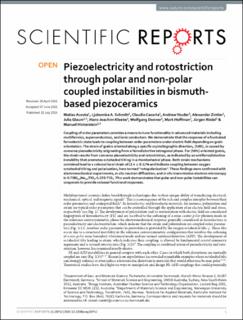| dc.contributor.author | Acosta, Matias | |
| dc.contributor.author | Schmitt, Ljubomira Ana | |
| dc.contributor.author | Cazorla, Claudio | |
| dc.contributor.author | Studer, Andrew | |
| dc.contributor.author | Zintler, Alexander | |
| dc.contributor.author | Glaum, Julia | |
| dc.contributor.author | Kleebe, Hans-Joachim | |
| dc.contributor.author | Donner, Wolfgang | |
| dc.contributor.author | Hoffman, Mark | |
| dc.contributor.author | Rödel, Jurgen | |
| dc.contributor.author | Hinterstein, Manuel | |
| dc.date.accessioned | 2020-06-05T08:39:53Z | |
| dc.date.available | 2020-06-05T08:39:53Z | |
| dc.date.created | 2017-01-05T15:14:29Z | |
| dc.date.issued | 2016 | |
| dc.identifier.citation | Scientific Reports. 2016, 6 . | en_US |
| dc.identifier.issn | 2045-2322 | |
| dc.identifier.uri | https://hdl.handle.net/11250/2656911 | |
| dc.description.abstract | Coupling of order parameters provides a means to tune functionality in advanced materials including multiferroics, superconductors, and ionic conductors. We demonstrate that the response of a frustrated ferroelectric state leads to coupling between order parameters under electric field depending on grain orientation. The strain of grains oriented along a specific crystallographic direction, ⟨h00⟩, is caused by converse piezoelectricity originating from a ferrodistortive tetragonal phase. For ⟨hhh⟩ oriented grains, the strain results from converse piezoelectricity and rotostriction, as indicated by an antiferrodistortive instability that promotes octahedral tilting in a rhombohedral phase. Both strain mechanisms combined lead to a colossal local strain of (2.4 ± 0.1) % and indicate coupling between oxygen octahedral tilting and polarization, here termed “rotopolarization”. These findings were confirmed with electromechanical experiments, in situ neutron diffraction, and in situ transmission electron microscopy in 0.75Bi1/2Na1/2TiO3-0.25SrTiO3. This work demonstrates that polar and non-polar instabilities can cooperate to provide colossal functional responses | en_US |
| dc.language.iso | eng | en_US |
| dc.publisher | Nature Research | en_US |
| dc.rights | Navngivelse 4.0 Internasjonal | * |
| dc.rights.uri | http://creativecommons.org/licenses/by/4.0/deed.no | * |
| dc.title | Piezoelectricity and rotostriction through polar and non-polar coupled instabilities in bismuth-based piezoceramics | en_US |
| dc.type | Peer reviewed | en_US |
| dc.type | Journal article | en_US |
| dc.description.version | publishedVersion | en_US |
| dc.source.pagenumber | 8 | en_US |
| dc.source.volume | 6 | en_US |
| dc.source.journal | Scientific Reports | en_US |
| dc.identifier.doi | 10.1038/srep28742 | |
| dc.identifier.cristin | 1421841 | |
| dc.description.localcode | This work is licensed under a Creative Commons Attribution 4.0 International License. The images or other third party material in this article are included in the article’s Creative Commons license, unless indicated otherwise in the credit line; if the material is not included under the Creative Commons license, users will need to obtain permission from the license holder to reproduce the material. To view a copy of this license, visit http://creativecommons.org/licenses/by/4.0 | en_US |
| cristin.ispublished | true | |
| cristin.fulltext | original | |
| cristin.qualitycode | 1 | |

